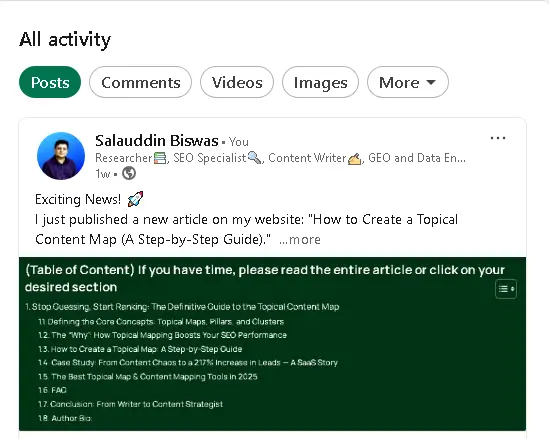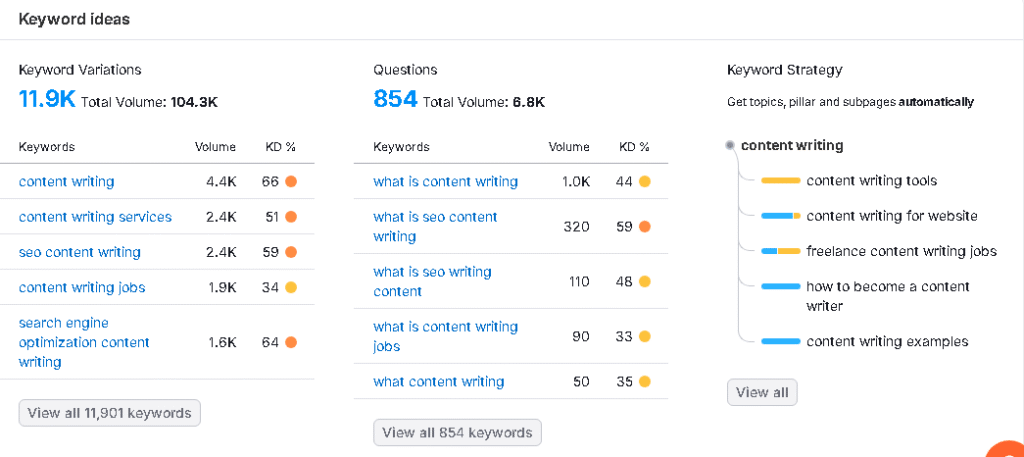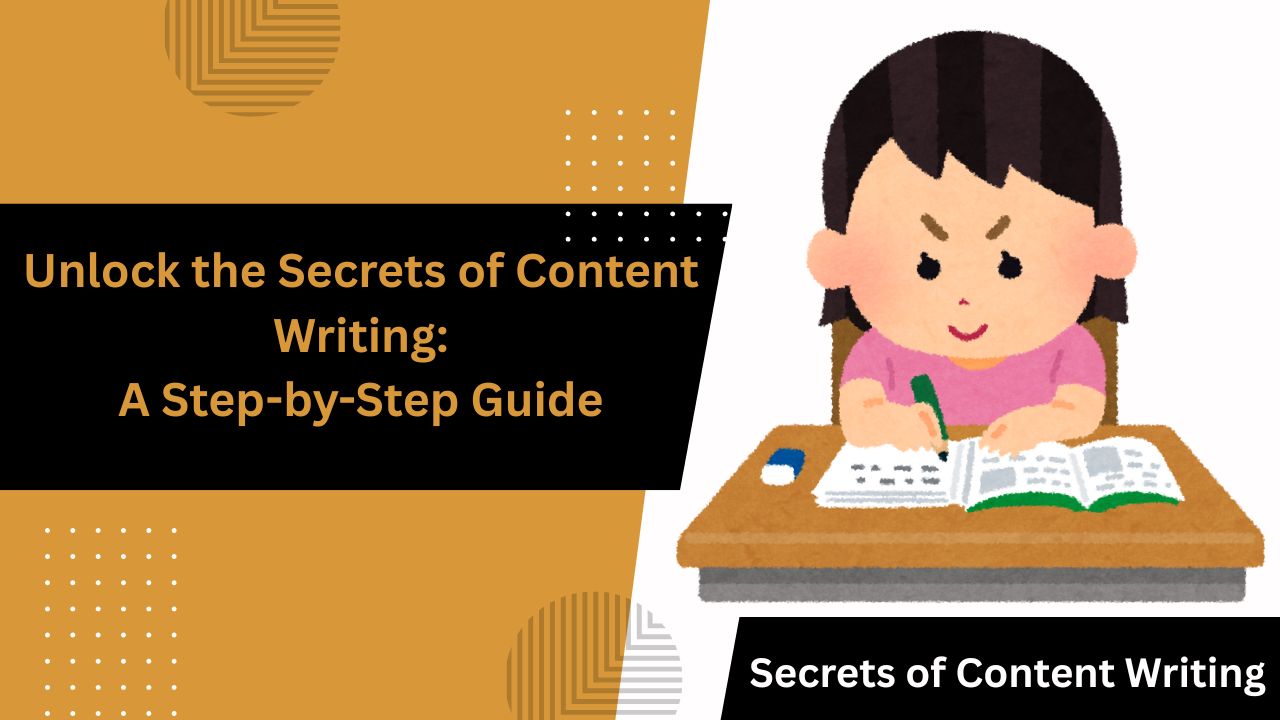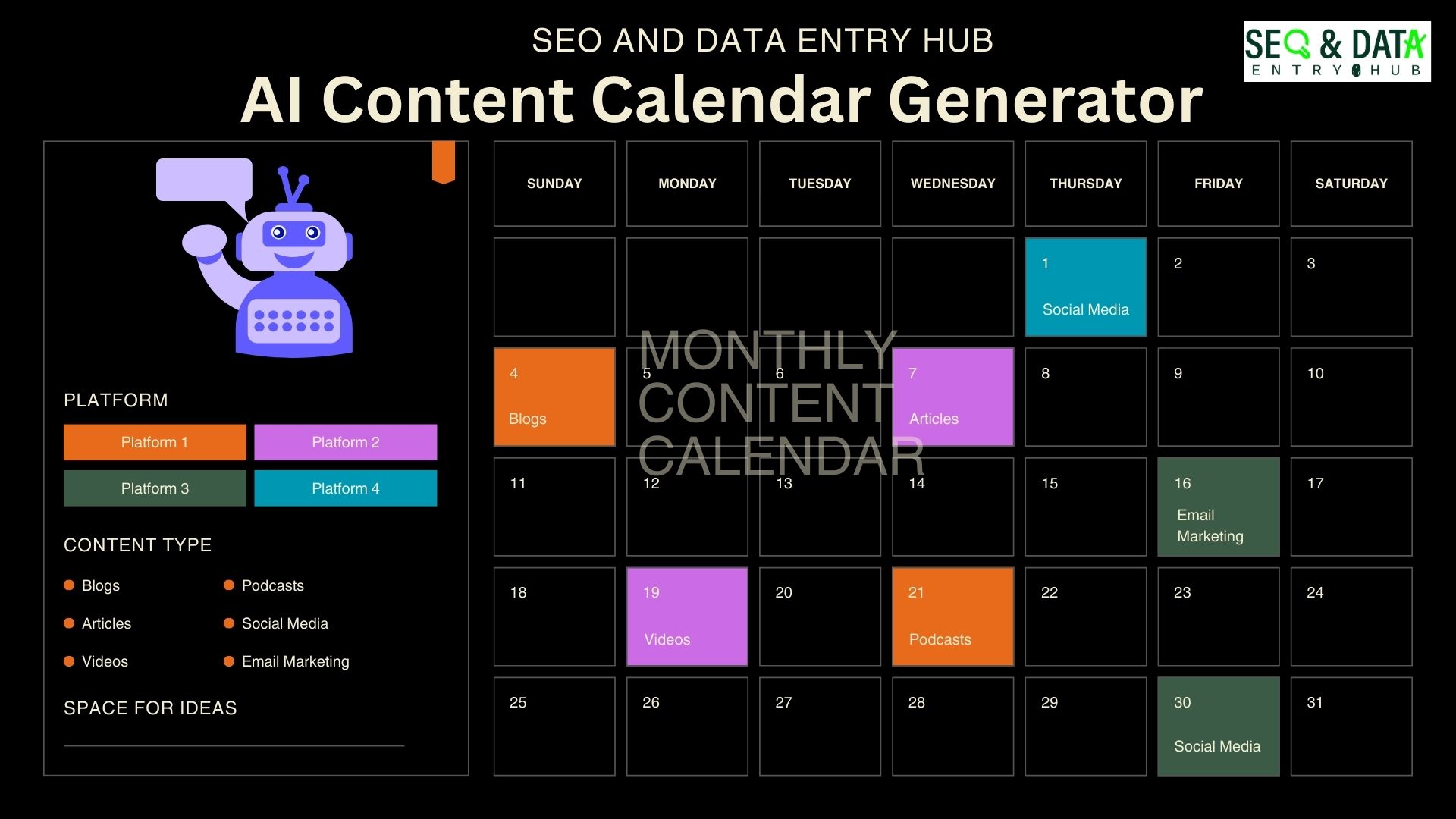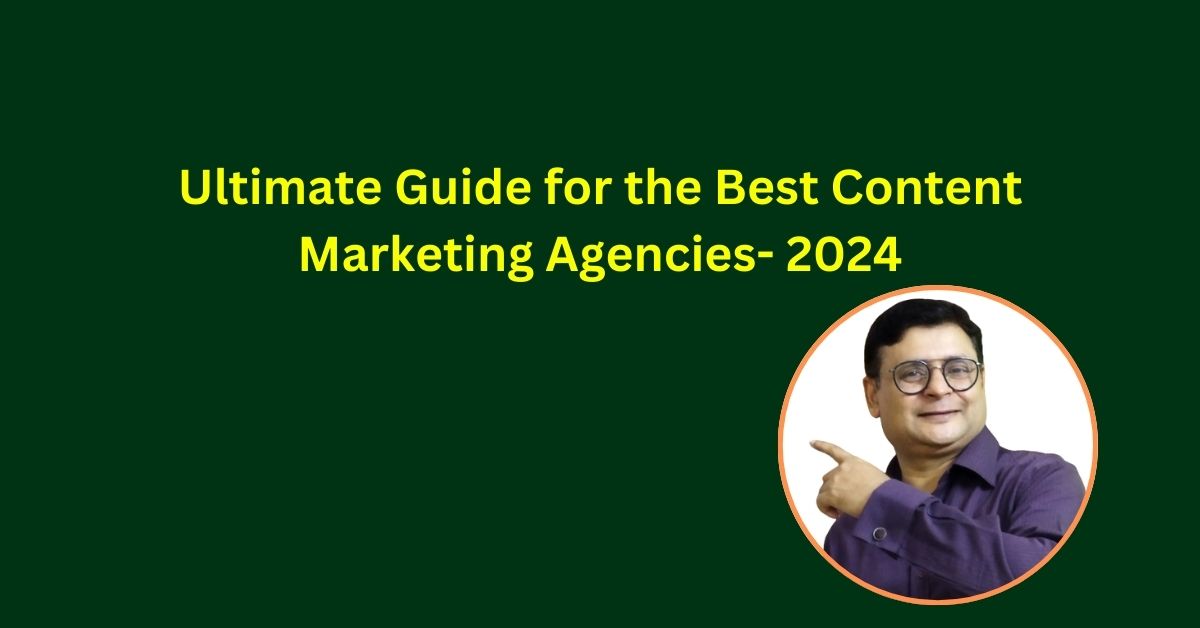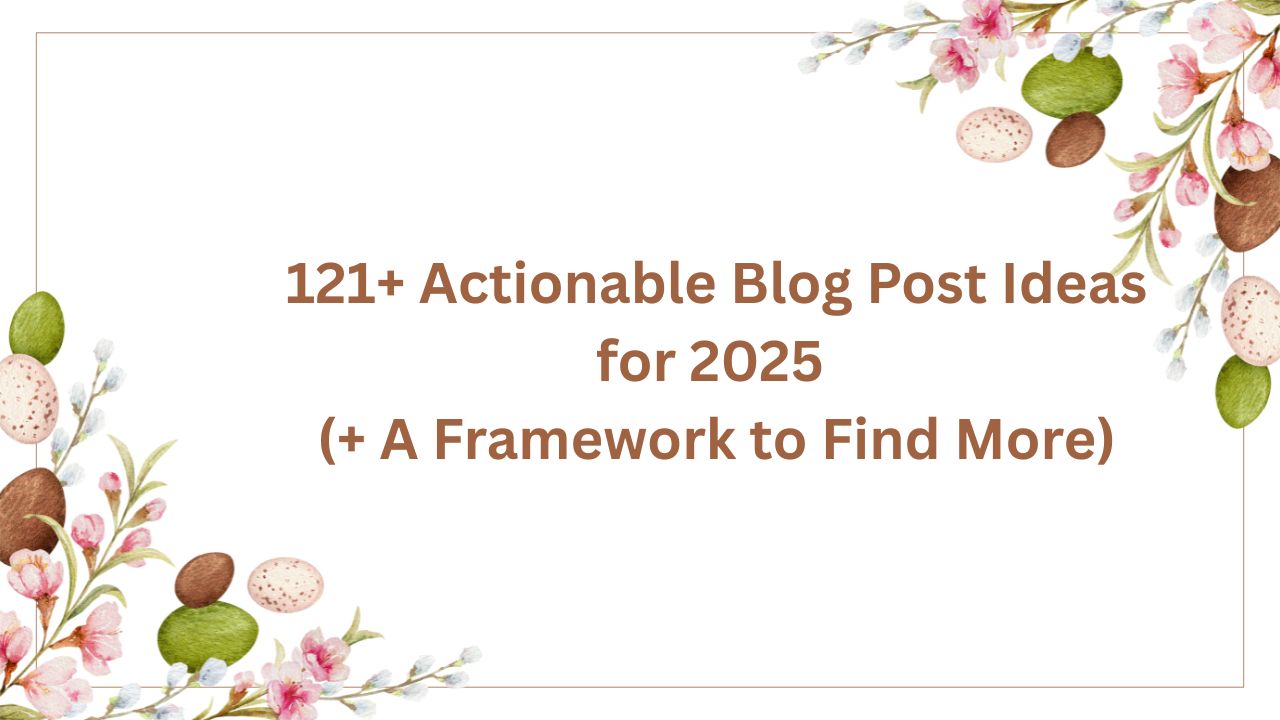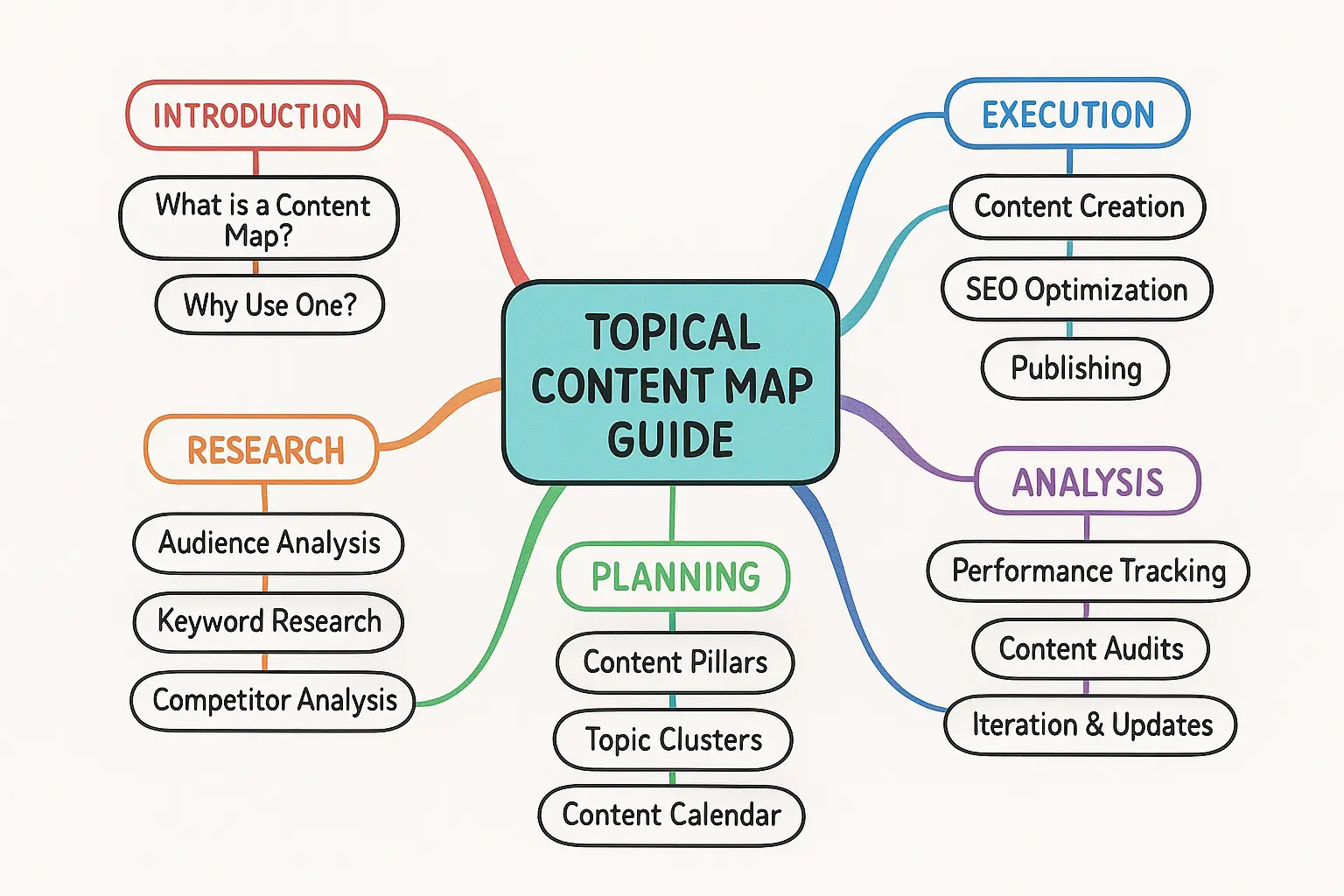
(Table of Content) If you have time, please read the entire article or click on your desired section
ToggleContent Writing: What It Is, Why It Matters & How to Start
Have you ever read an article, liked it, and just scrolled away—without clicking anything?
Then suddenly, another blog grabs you. It answers your question, feels like it’s written just for you, and—before you know it—you’ve clicked “Download,” “Sign Up,” or “Learn More.”
That’s not luck. That’s great content writing.
It speaks clearly. It builds trust. It makes people act.
And when done right, it also helps your page rank first on Google or drive massive organic traffic.
Whether you’re a business owner, blogger, marketer, or someone exploring career opportunities in content writing, understanding how content works is no longer optional—it’s a must.
In this guide, you’ll discover:
- What content writing really means in today’s digital world
- Why it’s essential for SEO, brand building, and audience engagement
- How to write SEO-optimized content that ranks and converts
- The types of content that attract, educate, and persuade readers
- And how to create content that solves problems, builds authority, and drives clicks
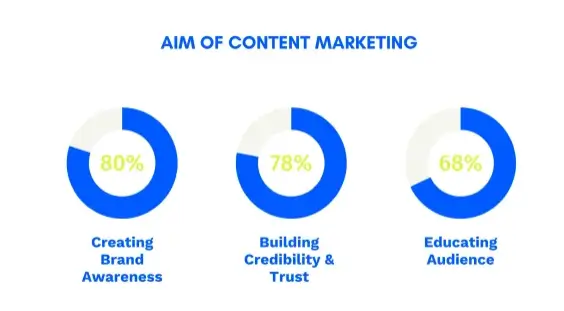
Ready to make your mark with powerful content that delivers results?
Let’s dive in—and see how content writing can help you grow, connect, and succeed.
What is Content Writing? Building Your Digital Voice
At first glance, content writing might seem like just writing for the internet. But in today’s digital world, it’s so much more than that.
Content writing means creating written material—like blog posts, product descriptions, landing pages, or email copy—that helps you reach clear goals.
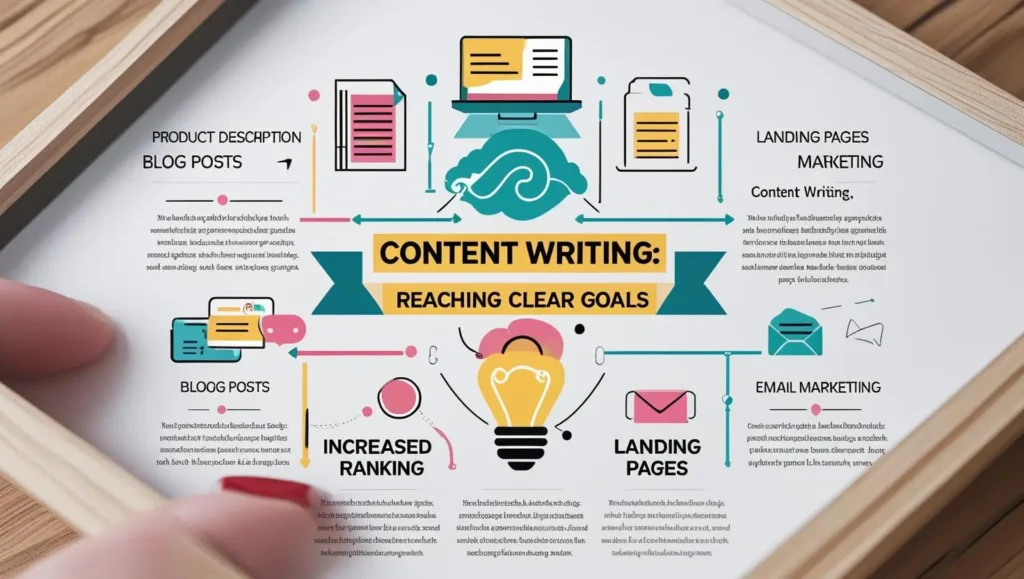
These goals might be to rank on Google, get more traffic, educate readers, or convince someone to buy.
Here’s how Ann Handley, author of Everybody Writes, explains the essence of content writing:
Content writing isn’t just words. It’s a way to connect with your audience, solve their problems, and build trust.
That’s the heart of content writing:
✅ Building trust
✅ Solving problems
✅ Connecting with people
✅ Driving results—like clicks, leads, and sales
Neil Patel, co-founder of NP Digital, explains it clearly:
Content marketing is really the backbone of any online marketing strategy. Without content, you have nothing to promote, nothing to rank for, and nothing to convert.
In short, if your business or website doesn’t have helpful content, it won’t grow online. That’s why content writing is more than just writing—it’s a strategy.
Here’s what great content writing helps you do:
- Build your brand voice
- Improve your position on the Search Engine Results Page (SERP)
- Get more traffic and leads
- Support your SEO and digital marketing strategy
Breaking Down Content Writing: What It Really Means
Based on expert advice and real-world data, effective content writing has four key parts:
✅ 1. Purpose-Driven Writing
Every piece of content should have a goal—to inform, persuade, educate, or entertain. If your content has no clear purpose, it will likely be ignored.
Quick Tip: Before writing, ask: What do I want this content to achieve? Is it to teach something, boost sales, or bring traffic?
✅ 2. Audience-Focused Content
Ann Handley says content should not be about you—it should be about your reader. That means writing with your audience’s needs, questions, and pain points in mind.
Quick Tip: Create simple audience profiles. Write like you’re helping a specific person solve a problem.
✅ 3. SEO-Optimized Structure
To get noticed on Google, your content must be SEO-friendly. Neil Patel’s advice is clear: If your content can’t be found, it can’t perform.
Basic SEO content writing includes:
- Focus and supporting keywords
- Keyword Difficulty (KD%) and search volume
- Competitor research and domain authority
- Meta title, meta tags, and mobile responsiveness
Quick Tip: Use bold headings, clear language, and naturally placed keywords to help both readers and search engines.
✅ 4. Real Value to the Reader
People come to your content looking for answers. If you solve their problem, they’ll trust you—and they’ll come back.
Quick Tip: Add real solutions, FAQs, tips, or examples. The more helpful your content is, the more likely people will stay and engage longer.
Why Content Writing Matters More Than Ever
📌 Why You Can’t Ignore Content Writing Anymore
In today’s fast-moving digital world, content writing is more than just putting words together. It’s a powerful tool that builds trust, drives traffic, and boosts sales.
Whether you’re a small business owner or a digital marketer, quality content can be your biggest asset.

Let’s explore how content writing works as a business driver, a measurable marketing tool, and a growing career path.
🔥 Content Writing Drives Real Business Growth
Content writing isn’t just about being creative. It’s about results. The right words can:
- Attract new visitors to your website
- Build brand awareness
- Generate leads and sales
- Improve search rankings
📈 The global content writing market is booming. The graph below shows how it’s expected to grow from USD 19.9 billion in 2023 to USD 38.6 billion by 2033, with a CAGR of 6.85%.
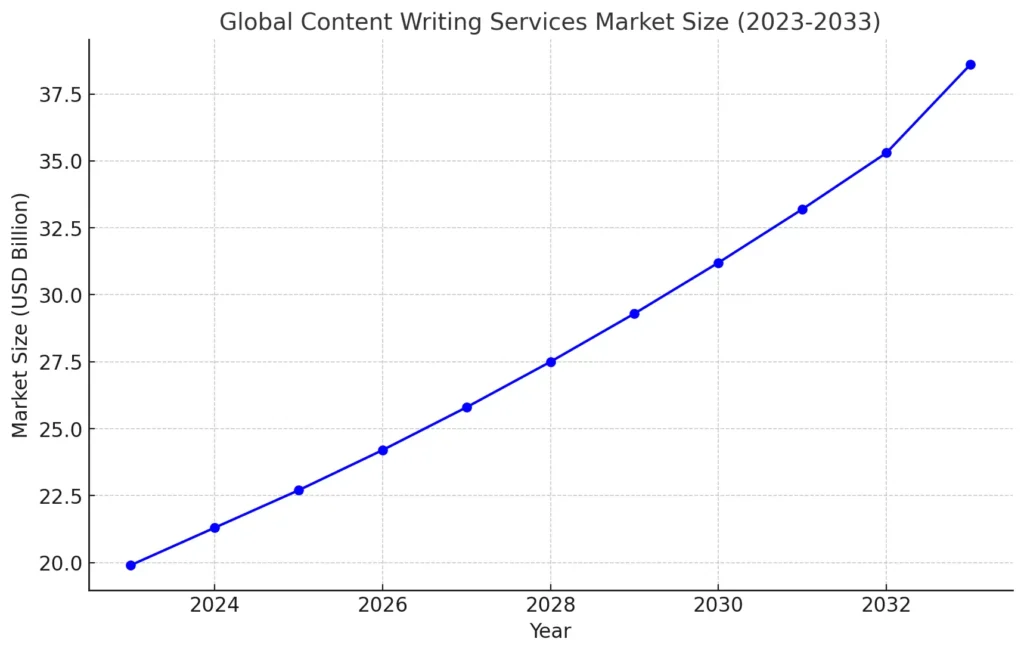
Source: Market.us Report
🌍 Demand for Every Type of Writing Is Rising
From article writing to copywriting and social media content, businesses need writers everywhere. The chart below breaks it down clearly.
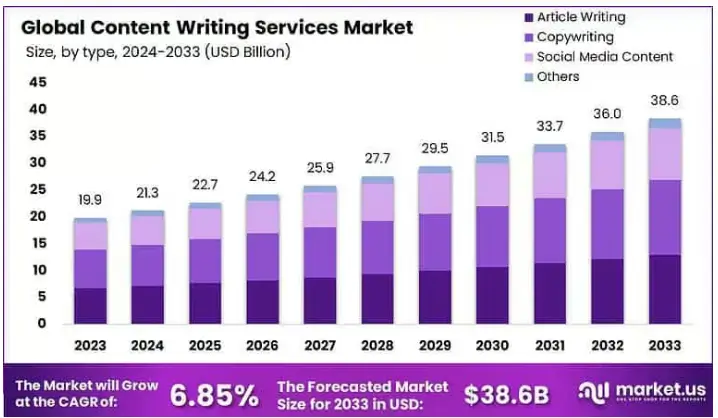
Source: Market.us Report
📊 You Can Measure the Impact of Content
One major advantage of content writing is that it’s measurable. You’re not guessing. You can track:
- Page views
- Bounce rates
- Time on page
- Click-through and conversion rates
These insights help you:
- Improve future content
- Show real ROI to clients or stakeholders
- Make smarter decisions for your content strategy
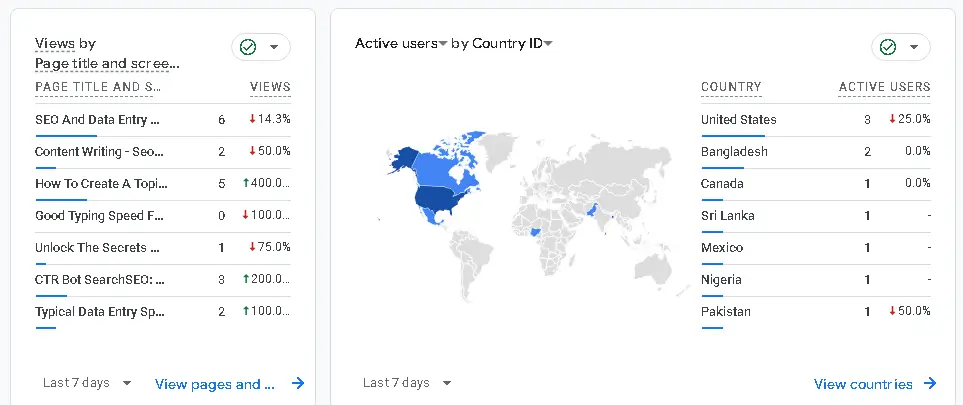
💼 A Growing Career Path with High Demand
As more businesses go digital, the demand for skilled content writers is skyrocketing. Whether you’re a freelancer or part of a marketing team, strong writing skills can open doors to real career opportunities.
The graph below shows how the content writing market is set to grow in regions like North America, Europe, and the U.S., making it a global job trend.
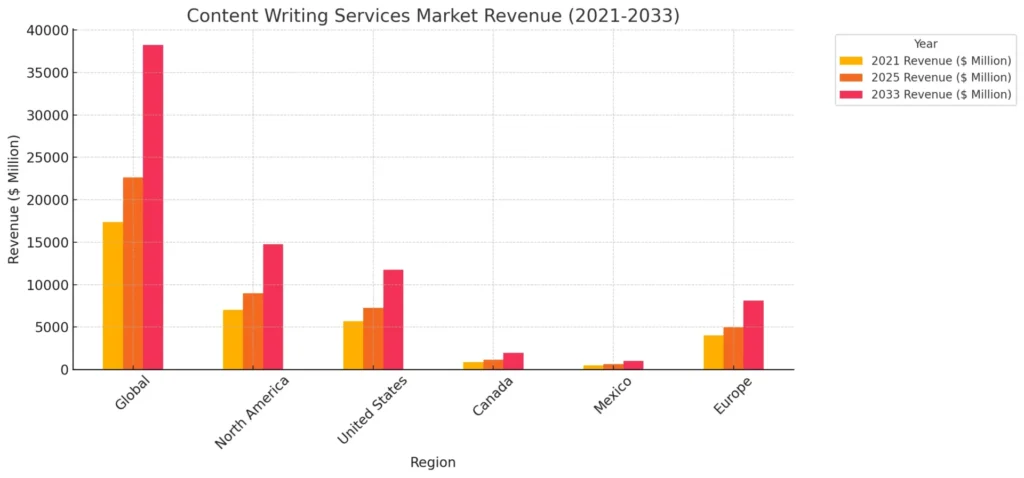
Source: Cognitive Market Research
✅ Key Takeaway
Content writing is no longer optional. It’s a vital part of any business strategy. It drives traffic, supports brand growth, and offers measurable returns—all while creating career opportunities in a growing global market.
How to Build a Winning Content Strategy
Before you write a single word, you need a solid, research-driven strategy. A strong content strategy isn’t just about publishing—it’s about aligning your content with your business goals and your audience’s needs.
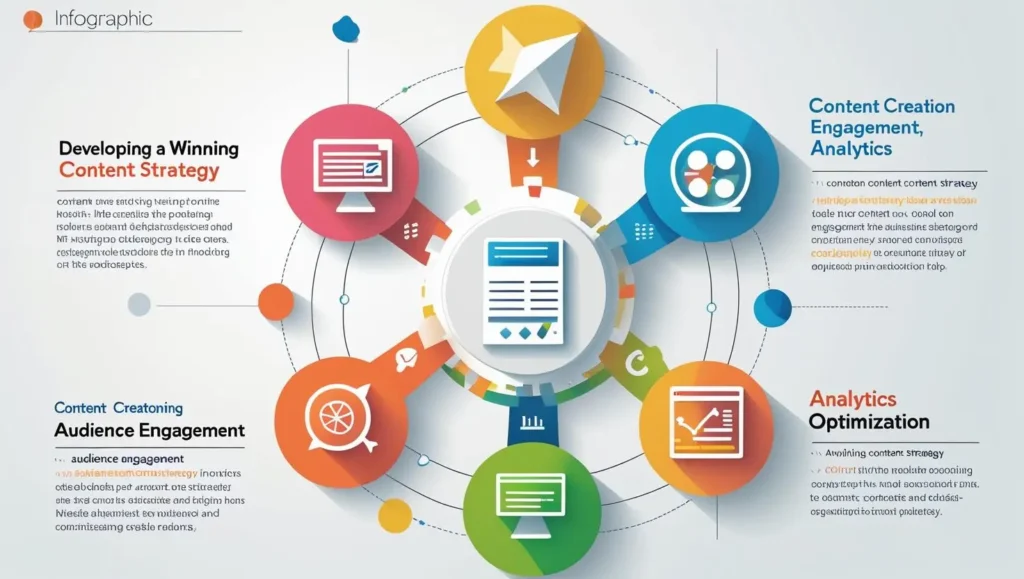
With a clear plan, your content won’t just appear on Google—it will speak directly to the right people, hold their attention, and move them to take action. This is how you build long-term relationships and grow a sustainable brand.
Types of Content Writing
Content writing includes a range of formats—each with its own purpose. Let’s explore the major types so you can build a well-rounded strategy:
Website Copy
Website copy refers to the text on your key pages—like Home, About, Services, and Contact. These are usually linked in the main navigation bar.
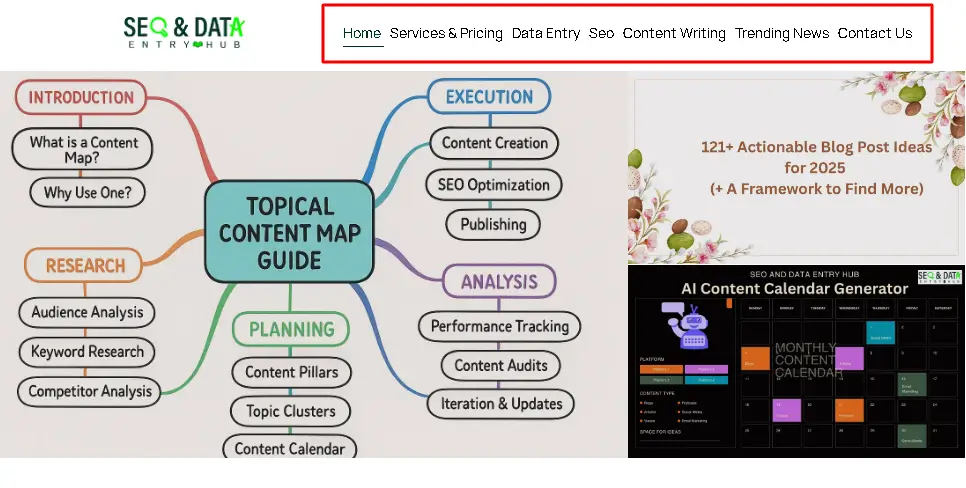
Your website copy should inform, guide, and persuade—while showing off your brand’s personality. Write in a voice that reflects your values, and make sure every line leads visitors toward taking action.
Blog Posts & Articles
These are the backbone of SEO content writing. They help you:
- Educate your readers
- Drive organic traffic
- Establish thought leadership
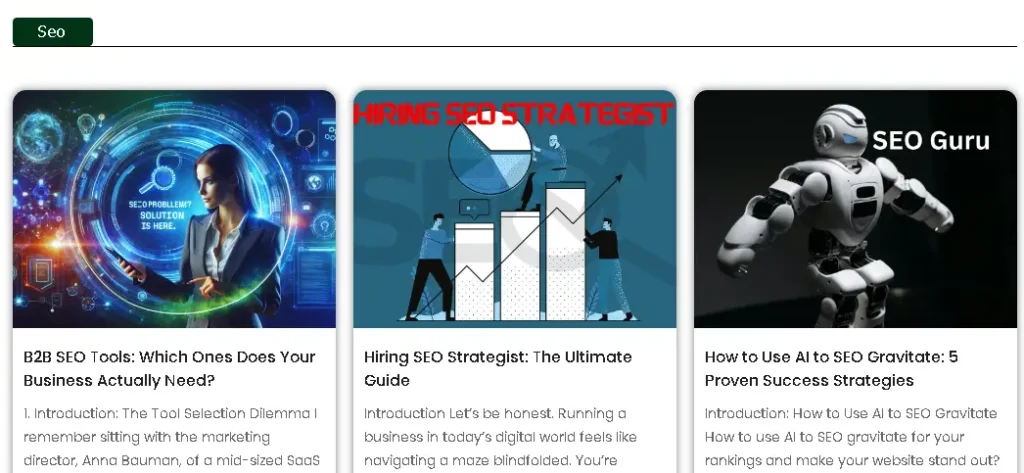
Blog post cards covering SEO strategy, AI, and hiring experts
Want your blog to rank and convert? Focus on value. Answer real questions. Use SEO keywords naturally, like “content writing for small businesses” or “SEO content writing tips.”
When you consistently publish helpful posts, people trust you. They come back for more. And eventually, they buy.
Product Descriptions
Think of this as your digital sales pitch. Great product descriptions:
- Explain features clearly
- Focus on benefits
- Solve customer pain points

Product description examples from Fabrics World USA and Jamuna Fertilizer
Use emotional triggers like “Save time” or “Feel confident.” Add long-tail keywords like “best organic skincare for dry skin” to boost visibility and conversion.
Social Media Content
Short, bold, and built to connect. Social posts help you:
- Drive engagement
- Build brand personality
- Send traffic to your site
Use trending topics, relatable language, and SEO-friendly captions. Speak like a real person. Ask questions. Tell stories. That’s how you build a community.
Email Marketing Copy
A great email feels personal. It grabs attention, delivers value, and encourages clicks. Whether it’s a weekly newsletter or a product promo, make it clear, human, and relevant.

Use the reader’s name. Show them something helpful. And always include a clear CTA—“Read Now,” “Download Free Guide,” or “Get 20% Off.”
Long-Form Content
Longer content like eBooks, guides, or whitepapers helps you:
- Build authority
- Explain complex topics
- Capture leads through gated content
Make it easy to scan with clear headings, visuals, and optimized keywords. Promote it through email and social media for maximum reach.
Case Studies & Testimonials
These are proof that your product or service delivers results. Real success stories build trust—especially when readers see themselves in your customers.
Show what the challenge was, what you did, and what changed. Use quotes, data, and storytelling to make it real.
Video Scripts
A good video starts with great writing. Whether it’s a tutorial or an ad, your script should:
- Be clear and conversational
- Address real audience needs
- Include SEO-friendly keywords
A powerful script can boost engagement and conversions more than any visual can alone.
💡 Quick Tip
Start with a blog post, follow up with an email, and finish with a testimonial. That’s how you turn a curious reader into a loyal customer. Mix content formats to match your customer journey.
Audience Targeting
You can’t write for “everyone.” Effective content starts with knowing exactly who you’re writing for.
Go Beyond Demographics
Knowing age and location isn’t enough. What are their challenges? What are they Googling? How do they feel?
🧠 63% of people expect brands to understand their needs. – Think with Google
Build Buyer Personas
Create simple profiles with:
- Demographics: Age, role, location
- Psychographics: Values, fears, goals
- Behavior: Search habits, social platforms
Match the Buyer’s Journey
People don’t decide overnight. Your content must guide them step by step:
- Awareness: They realize they have a problem
- Example: A blog post titled “Why Your Website Isn’t Ranking on Google”
- Consideration: They compare solutions
- Example: A guide like “Top SEO Tools for Beginners”
- Decision: They choose who to trust
- Example: A case study showing how your service helped someone like them
- Retention/Advocacy: They stick with your brand and recommend it
- Example: A customer newsletter, helpful tutorial, or loyalty program
Solve Their Problems
What keeps your audience up at night? Write content that answers that.
If they’re struggling with content writing, offer simple writing tips, SEO checklists, or templates. Show that you understand—and that your solution works.
According to HubSpot, businesses that align content with buyer personas see 73% higher conversion rates. Addressing specific pain points leads to better engagement and results.
Speak Their Language
Use the words they use. Avoid jargon. Mirror their voice. This improves both connection and SEO.
For example, If your readers type “how to write content for my website,” make sure your blog includes that phrase naturally.
Improve Continuously
Your audience evolves—so should your strategy—and you should track performance using Google Analytics (GA) and Google Search Console (GSC). Update your personas by using social media. Keep refining by using keyword research platforms like Semrush.
Content Purpose
Every piece of content should have a clear goal. Without one, even the best writing won’t work.
Here’s what purpose-driven content can help you achieve:
| Purpose | Goal | Example Content |
| Brand Awareness | Let people know you exist | “What Is Content Writing?” blog post |
| Educate & Inform | Teach or solve a problem | Step-by-step SEO guides |
| Lead Generation | Collect contact info | eBooks, templates |
| Lead Nurturing | Build trust over time | Email series, blog updates |
| Sales & Conversions | Get people to take action | Landing pages, product pages |
| Improve SEO | Rank higher in search | Keyword-rich blog posts |
| Build Community | Spark engagement | Interactive polls, comment-friendly posts |
| Thought Leadership | Become a go-to expert | Opinion articles, research reports |
🎯 Pro Tip: Always ask, “What do I want this content to achieve?” Then reverse-engineer your copy to hit that target.
Crafting Great Content: Turning Ideas into Impact
Creating standout content is not just about writing well—it’s about writing with intention. Each word, sentence, and paragraph should serve a clear purpose: to educate, engage, convert, or inspire your audience.
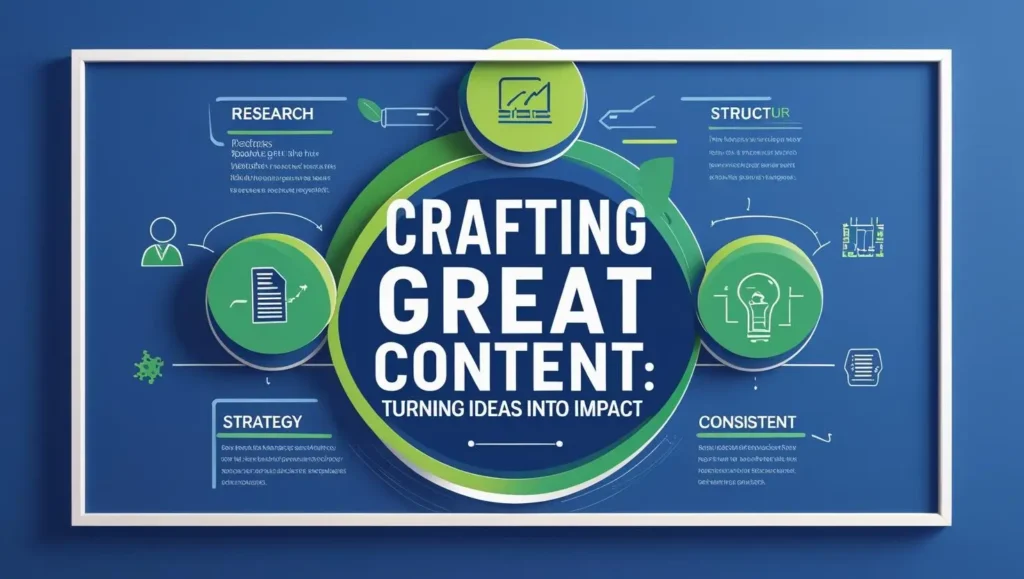
Many business owners or writers make the mistake of prioritizing volume over value. But great content isn’t created by accident—it’s the result of research, strategy, structure, and a consistent voice.
Let’s break down how to craft content that not only performs—but drives long-term growth and visibility.
Research: The Foundation of Content That Works
Without research, content is guesswork. To answer your audience’s real questions and meet their search intent, you need solid, data-driven insights.
✅ How to Research with Impact
Start with Keyword Research
Don’t just chase volume. Use tools like Semrush, Ahrefs, or Google Keyword Planner to find:
- Untapped, low-competition keywords
- Long-tail search queries your audience is actually using
Understand Your Audience Deeply
Write for real people. Are you speaking to busy small business owners? They need simplicity. Are your readers aspiring writers? Offer actionable tips and SEO frameworks.
Spy on Competitors—Then Do Better
Top-ranking content is your benchmark. Study what’s working—and identify what’s missing. Fill in the gaps with stronger, more helpful, more current content.
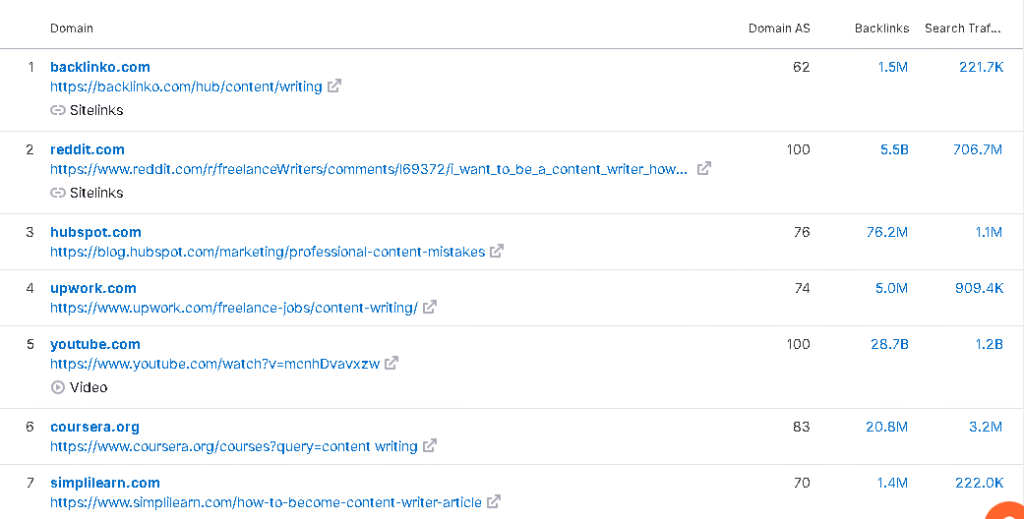
Use Real Data and Expert Sources
Cite statistics, studies, and authoritative voices to build trust. Backing up your claims shows professionalism and boosts credibility.
Watch Industry Trends
Algorithms, user behavior, and tools are always evolving. Stay updated so your content doesn’t become outdated. Adding trending keywords like “SEO trends 2025” early can also help future-proof your traffic.
💡 Final Insight: Think of research as your raw materials. Without them, even the best writing can fall flat. With them, your content becomes insightful, targeted, and trustworthy.
Tone & Style: Finding and Keeping Your Voice
Your content’s tone and style aren’t just about word choice—they’re how your brand speaks to the world.
A consistent voice helps you build recognition, connection, and credibility across all platforms—from blog posts to landing pages.
🎯 Define Your Brand Voice
Ask yourself:
- Do you want to sound authoritative, casual, empathetic, or playful?
- What tone will resonate most with your target audience?
📝 Example: A tech company might sound analytical and precise. A lifestyle brand may sound friendly, conversational, and witty.
Once defined, document your tone guidelines so your whole team can stay consistent.
🎯 Align Tone with Your Audience
- B2B Readers → Professional, data-driven, and trustworthy
- Lifestyle/Consumer Readers → Conversational, helpful, and relatable
Use long-tail keywords that match their intent, like: “how to write content for business websites”.
🎯 Match Tone to Purpose
- Guides & How-tos: Clear, calm, and educational
- Sales Pages: Persuasive, confident, and benefit-driven
- Blog Posts: Friendly, empathetic, and insightful
✍️ Quick Tip: Tone = Emotion
Your audience may forget the details—but they’ll remember how your content made them feel.
Structure & Process: The Backbone of High-Performing Content
Even the best ideas can fail without proper organization. A clear structure helps:
- Keep readers engaged
- Improve SEO
- Communicate your message with clarity
Think of structure as the user experience of your writing.
🧱 Why Structure Matters
Search engines love organized content. So do busy readers. Structured writing makes content easier to skim, understand, and retain.
✏️ Outlining: Your Blueprint for Success
Before you start writing, take time to map out your content. A clear outline directs your content, ensures nothing important is left out, and keeps your message focused. Here’s a simple structure you can follow:
| Section | What to Do |
| Introduction | Hook the reader, state your main idea, preview what’s inside |
| H2 Headings | Break the topic into main categories or questions |
| H3/H4 Subheadings | Add structure within sections for clarity |
| Key Points | Use bullet lists, callouts, or examples for emphasis |
| Conclusion | Summarize takeaways and add a clear CTA |
📖 Keep the Flow Natural
Each section should lead smoothly into the next. Use:
- Transitions between paragraphs
- Mini-summaries to wrap up sections
- Teasers that build momentum
🖍️ Readability & Formatting Tips
Most online readers scan before they read, so make your content easy to digest at a glance. Use the following formatting best practices:
| Element | Purpose |
| Short Paragraphs | Keep to 2–4 lines to reduce overwhelm |
| Bullet Points | Present steps, benefits, or facts clearly |
| Bold Text | Emphasize key ideas or action steps |
| White Space | Improve scanning and visual clarity |
These formatting strategies help reduce bounce rates and improve time-on-page.
The Content Creation Process: Step-by-Step
Behind every great piece of content is a system. Use this repeatable process:
| Stage | What to Do |
| Strategy & Planning | Set clear goals, topics, and target personas |
| Research | Find reliable data, keywords, and competitor insights |
| Outlining | Organize your content flow |
| Drafting | Write without self-editing—get the ideas out |
| Editing & Revising | Refine structure, tone, and logic |
| Proofreading | Fix grammar, punctuation, and typos |
| SEO Optimization | Add keywords, meta tags, internal links, and alt text |
| Publishing | Format for mobile and web readability |
| Promotion | Share across email, social media, and content hubs |
| Performance Analysis | Track views, CTRs, bounce rate, and conversions |
🧠 Quick Tip: A repeatable process makes quality scalable. Your voice stays strong. Your message stays clear. And your content keeps delivering value.
How to Optimize and Finalize Content That Performs
You’ve written your first draft—great start! But the job isn’t done.
To turn that rough draft into standout content that ranks, converts, and builds trust, it needs to be optimized and polished.

This stage makes your writing clearer, sharper, and more discoverable. It’s also where your content gets a final quality check—ensuring it’s engaging for readers and visible to search engines.
Editing & Proofreading: Turn Rough Drafts into Polished Powerhouses
Even the best ideas fall flat without clean execution. Poor grammar and unclear writing cost you trust and traffic.
🔍 The Data Speaks:
- Pages with grammar/spelling errors had an 85% higher bounce rate (AgilityPR.com).
- 59% of readers would avoid buying from a brand with frequent language mistakes (LinkedIn).
🛠️ What to Focus On:
| Area | What to Check |
| Clarity & Conciseness |
|
| Grammar & Punctuation |
|
| Flow & Cohesion |
|
| Fact-Checking |
|
| Review Process |
|
💡 Quick Tip: Multiple rounds of revision are worth it. One typo can damage your authority.
SEO Basics: Make Your Content Findable
Even brilliant content won’t perform if it can’t be found. Over 90% of online experiences begin with a search (Search Engine Journal). SEO isn’t optional—it’s essential.
✅ Keyword Integration
What is it? Placing relevant keywords naturally within your content.
Why it matters: It helps search engines understand your topic and match it to user intent.
How to do it:
- Use main and related keywords in titles, headers, and body text.
- Include long-tail keywords to match specific queries.
- Avoid keyword stuffing—focus on readability.
✅ Title Tags & Meta Descriptions
What are they? Your page’s first impression in Google.
Why it matters: They drive clicks and tell both users and search engines what your content is about.
How to write them:
- Title tag: Use your main keyword, keep it under 60 characters.
- Meta description: 150–160 characters, clear summary, include keywords.
🧠 Example:
- Title: SEO Content Writing Tips: Boost Your Rankings
- Meta Description: Learn practical SEO content writing tips to create optimized, high-ranking content.
✅ Image Optimization
Why it matters: Faster load times, better accessibility, and additional keyword relevance.
Best Practices:
- Use descriptive, keyword-rich file names (e.g., seo-content-strategy.webp)
- Add alt text describing each image
- Compress images without losing quality
✅ Internal & External Linking
What it means:
Internal links take readers to other pages on your website.
External links lead to well-known, trustworthy sources outside your site.
Why it matters: Helps guide readers and boosts SEO.
Tips:
- Internal links: Link to related content on your site.
- External links: Cite credible sources (studies, industry leaders).
✅ Readability & User Experience
Why it matters: If your content is hard to read or your site is slow, users leave—and Google notices.
Make it better:
- Use short paragraphs and bullet points
- Add headings to break up content
- Improve site speed by compressing images
💬 Professor’s Insight:
SEO isn’t just about pleasing algorithms—it’s about serving people. When content is helpful, clear, and accessible, both users and search engines will reward it. (Rob Scott, The Psychology of SEO: Crafting Messages That Connect with People and Algorithms, Today Digital)
Tools & Resources: Boost Quality, Save Time
Great content takes time—but smart tools can speed up the process while keeping quality high. From grammar to SEO to project management, here’s your go-to toolkit.
🧰 Writing & Grammar Tools
Clear writing builds trust with your readers. Tools like Grammarly or Hemingway can spot grammar mistakes and awkward phrases, helping your content read smoothly and feel more professional.
| Tool | Features | Best For |
| Grammarly | Grammar, spelling, punctuation | All content types |
| ProWritingAid | Style, tone, readability analysis | Long-form, professional writing |
| Hemingway Editor | Simplifies sentences, boosts clarity | Web and blog writing |
🔍 SEO Tools
You need reliable tools if you want your SEO blog posts or website pages to rank higher. They support keyword research, track competitors, and improve your search performance.
| Tool | Features | Best For |
| Google Keyword Planner | Keyword trends, suggestions | Keyword research |
| Google Search Console | Tracks performance, indexing issues | Monitoring and fixing SEO |
| SEMrush / Ahrefs / Moz | Backlink data, competitor analysis | Advanced SEO strategy |
| Yoast SEO / Rank Math | Meta tags, readability, on-page SEO | WordPress users |
🔏 Plagiarism Checkers
Originality matters. Plagiarism checkers ensure your content is unique, protecting your SEO and building trust with your audience.
| Tool | Main Features | Best For |
| Copyscape | Finds duplicate content | Ensuring originality |
👓 Readability Tools
If your content is hard to follow, readers will leave. Readability tools help you write clearly, which is great for your audience and even better for SEO.
| Tool | Main Features | Best For |
| Hemingway Editor | Highlights complex or passive sentences | Web-friendly writing |
| Flesch-Kincaid Score | Reading level analysis | Matching tone to target audience |
🖼️ Image Optimization Tools
Images make your content more engaging, but large files can slow your site down. These tools compress and resize images to improve page speed and boost your SEO.
| Tool | Features | Best For |
| TinyPNG / Compressor.io | Compress images fast | Speeding up web pages |
| Canva / Adobe Express | Resize and customize visuals | Creating blog graphics |
📅 Project Management Tools
| Tool | Features | Best For |
| Asana | Dashboards, calendar, teams | Team collaboration |
| Trello | Boards, checklists, cards | Content planning |
| Monday.com | Automations, workflows | Scaling operations |
💡 Professor’s Insight:
Tools can elevate your work, but they can’t replace your thinking. Use them to support your message—not write it.
Final Thoughts
Optimizing and finishing your content isn’t just about tweaking a few words or throwing in a keyword.
It’s about giving your audience the best possible experience—from first impression to final scroll. With smart editing, strategic SEO, and the right tools, your content doesn’t just live online—it performs.
Growing Your Content Writing Career
Why This Matters
Content writing isn’t just a skill—it’s a serious career path.
It gives you freedom, steady income, and room to grow.
According to Content Marketing Institute (CMI) (2024), 71% of B2B marketers say content marketing—powered by strong writing—matters more now than ever.
That’s why writers who know strategy, SEO, and audience needs are in high demand.
In this section, you’ll learn about common mistakes that hold writers back—and how to avoid them—so you can confidently grow your content writing career.
📛 Mistakes to Avoid
Even seasoned writers can fall into traps. These minor mistakes can slow your growth or hurt your credibility. Let’s walk through the most common pitfalls—and how to correct them:
- Neglecting Research
If your content lacks research, it lacks value. Ignoring audience insights, skipping keyword analysis, or failing to fact-check leads to forgettable content.
Fix: Start with tools like Semrush or Google Keyword Planner. Back up every point with reputable sources.
- Focusing on Volume Over Value
Publishing too often without substance confuses your audience and signals low quality to Google.
- Fix: Prioritize helpful, insightful writing—even if it means posting less frequently.
- Ignoring SEO Fundamentals
Excellent writing won’t get seen if it’s not optimized. Forgetting meta tags, internal links, or proper headers lowers your chances of ranking.
- Fix: Use on-page SEO tools like Yoast SEO or Rank Math. Follow SEO best practices consistently.
- Inconsistent Brand Voice
A shifting tone weakens trust. Your content should sound familiar and aligned across every touchpoint.
- Fix: Create a brand voice guide and stick to it in blogs, emails, and social posts.
- Skipping Editing and Proofreading
Typos, awkward phrasing, and unclear thoughts reflect poorly on your professionalism.
- Fix: Use tools like Grammarly, Hemingway, or hire an editor. Always revise before publishing.
- Failing to Evolve
Sticking to outdated methods puts you behind. Platforms, formats, and search engines evolve.
- Fix: Follow industry blogs. Update your skills regularly. Adapt to changes.
- Writing for Bots, Not People
Keyword stuffing ruins user experience and can harm your rankings.
- Fix: Use keywords naturally. Prioritize helpful, human-centered content.
- Not Promoting Your Work
Even great content can flop if no one sees it.
- Fix: Share on social media, newsletters, LinkedIn, and relevant communities. Repurpose into reels, carousels, or infographics.
- Ignoring Performance Data
If you don’t track performance, you can’t improve.
- Fix: Monitor metrics like bounce rate, engagement, and rankings with Google Analytics and Search Console.
- Plagiarism or Missing Attribution
Uncredited content damages credibility—and can lead to legal consequences.
- Fix: Always cite your sources. Use plagiarism checkers before you hit publish.
Quick Tip:
Mistakes aren’t failures—they’re feedback. The best writers are great editors of their own habits.
📊 Best Practices
Growing a sustainable writing career means going beyond talent. The writers who thrive follow proven habits that deliver value and stay relevant.
Stay Current with Industry Trends
The digital space evolves constantly. New tools, formats, and platforms appear every year.
- Use tools like Google Trends, Surfer SEO, or ChatGPT to stay ahead.
Sharpen Your Core Skills
Beyond grammar and structure, master storytelling, SEO, formatting, and tone. Understand how to write for blogs, videos, newsletters, and landing pages.
Find Your Niche
Specialization makes you memorable. Whether it’s SaaS, health, finance, or UX copy—you’ll stand out faster with focused expertise.
Build a Results-Driven Portfolio
Don’t just show work—show outcomes.
- Label projects clearly: “Blog post that ranked #1,” or “Email campaign with 40% open rate.”
Use Data to Improve
Great content writers use analytics to guide their strategy. Know what’s working—and why.
Collaborate & Network
Join writing communities, engage on LinkedIn, or contribute guest posts. Opportunities often come from relationships.
Grow Your Personal Brand
Share your insights. Publish your learnings. Thought leadership builds visibility and attracts clients.
Write for the Reader
Every piece must solve a real problem. When you help your audience, Google will help you too.
Work Cross-Functionally
Learn how to collaborate with designers, SEOs, developers, and marketers. It elevates your impact.
Prioritize Self-Care
Creativity needs rest. Avoid burnout with boundaries, breaks, and balanced work.
Ask for Feedback
Constructive feedback is one of the fastest ways to grow.
Professor’s Insight:
Best practices are not rules—they’re habits. Develop them, repeat them, and you’ll build a reputation that outlasts algorithms.
🌐 Career Opportunities in Content Writing
Content writing is far from a dead-end job. It’s a fast-growing field with career tracks for every skill level.
Content Writer / Creator
You’ll write blog posts, web pages, articles, or descriptions. This is the entry point to build your voice and skill.
SEO Content Specialist
Mix creativity with data. You focus on ranking strategies, keyword optimization, and traffic-driving content.
Copywriter
You write to persuade. Whether it’s ads, landing pages, or email sequences, your words drive action.
Content Strategist
You plan the content roadmap. Your work includes editorial calendars, voice guidelines, and aligning writing with brand goals.
Content Marketing Manager
You manage content creation, promotion, and measurement—often leading teams and connecting strategy to ROI.
Editor / Proofreader
You ensure clarity, tone, and quality. From grammar checks to structural edits, your job is vital to professionalism.
Technical Writer
Turn complex topics into user-friendly documentation. Ideal for those who love clarity, precision, and structure.
UX Writer / Content Designer
You write for digital experiences—from app instructions to button copy. A perfect blend of writing and design thinking.
Social Media Content Creator
Quick, catchy, and visual content is your focus. You craft posts and campaigns for brand engagement.
Video Scriptwriter / Producer
You script explainer videos, YouTube content, or branded storytelling. Strong visual thinking is key.
Freelance Content Creator
Choose your clients, set your schedule, and explore different industries. Freelancing allows you to shape your career your way.
Quick Tip:
Whether you prefer punchy ad copy or in-depth guides, there’s a path for you. Find your strength, develop your edge, and build a portfolio that proves your value.
🧭 Case Study: How Inspire Fitness Used SEO Content Writing to Build a Powerful Local Brand
📌 The Challenge: A Brand Stuck on Social
Inspire Fitness, a boutique gym in Dhaka, Bangladesh, had a loyal local following on Instagram. Their posts were liked and shared — but their website told a different story.
Organic traffic was flat. Blog visits? Almost nonexistent. Worse, their site ranked on page 4 or lower for all their key services, like personal training in Dhaka or nutrition coaching for beginners.
Owner’s frustration?
“We had amazing trainers and great results, but online, we were invisible.”
🧠 The Strategy: Writing That Speaks to Real People
That’s when they brought me in to reshape how they told their story online.
Here’s what changed:
-
Audience Research – We identified two core personas: young professionals looking to stay fit and new moms seeking safe postnatal workouts.
-
Keyword-Driven Blog Content – Topics included “How to Stay Fit During Ramadan” and “Beginner Gym Mistakes to Avoid”.
-
SEO Optimization – Titles, meta descriptions, and headings were rewritten using localized keywords to improve visibility in local searches.
-
Web Copy Overhaul – The home, service, and about pages were rewritten with clear CTAs, benefit-focused messaging, and content writing for business growth in mind.
🚀 The Transformation: From Page 4 to Page 1
Within 4 months, Inspire Fitness experienced:
-
📈 Website traffic grew 320%
-
🔍 5 blog posts ranked in the top 10 for competitive local fitness keywords
-
📞 Inquiries through the contact form tripled
-
💬 Clients mentioned finding them through Google — for the first time ever
🎯 The Lesson: Content Writing = Visibility + Trust
Inspire Fitness didn’t change its product.
They just started telling their story better — and Google took notice.
“Once we treated our content like an extension of our brand voice, people found us. And they stayed.”
— Taj, Owner of Inspire Fitness
💡 Takeaway for You
If you’re a small business, local brand, or solo entrepreneur, SEO content writing is your most affordable and scalable marketing tool.
When it’s done with purpose and strategy, it’s not just about ranking — it’s about connecting with real people and building trust over time.
Final Thoughts: Content Writing That Drives Results
Content writing isn’t just a nice extra—it’s the engine behind your online growth. Whether you’re building a brand, reaching new audiences, or climbing Google’s rankings, it all starts with strong, purposeful content.
This guide has walked you through the entire process—from setting your strategy and understanding your audience to writing with clarity, optimizing for SEO, and growing a real career in writing.
If you’ve made it this far, you’re not guessing anymore—you’re making smart, informed choices that can set your content apart.
And here’s the truth: You don’t need more content. You need the right content.
One well-written page that speaks to your audience’s needs can outperform 20 rushed posts that miss the mark.
💡 Writer’s Insight
Content writing is always evolving.
Search engines update. Audiences shift. But your edge comes from learning, testing, and improving. That’s how you turn your content into a long-term asset that builds authority and trust.
✅ Your Next Step Toward Content Mastery
This guide is just the start.
If you’re ready to write content that truly ranks, converts, and connects—we’ve created tools, templates, and resources to help you go further.
👉 Explore Our Advanced Content Resources
Frequently Asked Questions (FAQ)
Have questions about content writing, strategy, or SEO? You’re not alone. Here are answers to the most common queries we hear.
If your question isn’t listed, feel free to reach out—we’re here to help.
- What is content writing?
Content writing means creating valuable, clear, and SEO-friendly content for your audience. It includes writing blog posts, website copy, product descriptions, and more.
The goal is to inform, educate, or persuade while helping your content rank well on Google. Whether you’re a freelance writer or offering content writing services, your job is to connect with readers and solve their problems.
- How do I start content writing?
Start by picking a niche and learning about your target audience.
Then:
✅ Practice writing regularly
✅ Learn the basics of SEO content writing
✅ Build a portfolio
✅ Take online courses or apply for entry-level content writing jobs
✅Consistency and improvement will help you grow.
- What is an example of content writing?
Here are a few:
- A blog post that teaches small businesses how to use SEO
- A product description on an eCommerce site
- A guide on using AI for content creation
- A service page for a freelance content writer
- What is SEO writing?
SEO writing means writing content that ranks on Google.
It uses strategies like:
- Adding the right keywords
- Using headings and subheadings
- Making your writing easy to read
- Following on-page SEO rules
- If you offer SEO content writing services, staying current with trends is key.
- What skills do content writers need?
Successful writers need:
- Strong grammar and editing skills
- SEO knowledge
- Research abilities
- Creativity and adaptability
- You may write for different formats—blogs, ads, emails, or even freelance projects.
- What is the meaning of content in writing?
“Content” is the message you share—written for blogs, websites, social media, or marketing.
Great content helps your audience and improves visibility in search engines.
- What are types of content writing?
Popular types include:
- Blog writing: Informative or engaging posts
- Copywriting: Persuasive writing for ads
- Technical writing: Manuals and how-to guides
- SEO writing: Optimized content for rankings
- Product descriptions: Focused on features and benefits
- Freelance writing: Client-based content work
- How to use keywords in content writing?
To use keywords smartly:
- Add them to titles and subheadings
- Include them naturally in body text
- Use long-tail keywords for specific search intent
- Avoid stuffing—write for people first
- How do I write content for SEO?
To create strong SEO content:
- Do keyword research before writing
- Add keywords to headings and paragraphs
- Use short paragraphs and bullet points
- Link to other pages on your site (internal linking)
- Include trusted external sources
- Always write for readers, not just search engines.
- How to start content writing from home?
To begin your content writing career from home:
- Write sample content and build a portfolio
- Learn SEO writing techniques
- Create a profile on platforms like Upwork or Fiverr
- Keep learning from blogs, webinars, and courses
- With time, you can turn content writing into a full-time income.
Author Bio
Salauddin Biswas – SEO Specialist, Content Writer, and AI Content Editor
I’m Salauddin Biswas, founder of SEO & Data Entry Hub and Co-founder of S A Websoft. I am a content strategist with a research background. I help businesses turn ideas into content that ranks, engages, and drives results. Over the years, I’ve worked with brands across industries to blend SEO, data insights, and human storytelling—so they stand out in a crowded online space.
You can Visit Our Social Pages:
✅ LinkedIn:
https://www.linkedin.com/in/salauddin-writer-seo-dataentry/
✅Facebook:
https://www.facebook.com/profile.php?id=61557149480263
✅ Instagram:
https://www.instagram.com/seoanddataentry/
✅ Twitter:
https://x.com/SalauddinB1980/
✅ Pinterest:
Link: https://www.pinterest.com/seoanddataentryhub/
✅ YouTube:
URL: https://www.youtube.com/channel/UCCP5sGmyvOw4fuyDkZVO_Sg
✅ Medium: https://medium.com/@SalauddinSEOandDataEntryhub
To get our services:
🚀 https://www.fiverr.com/data_entry_80

